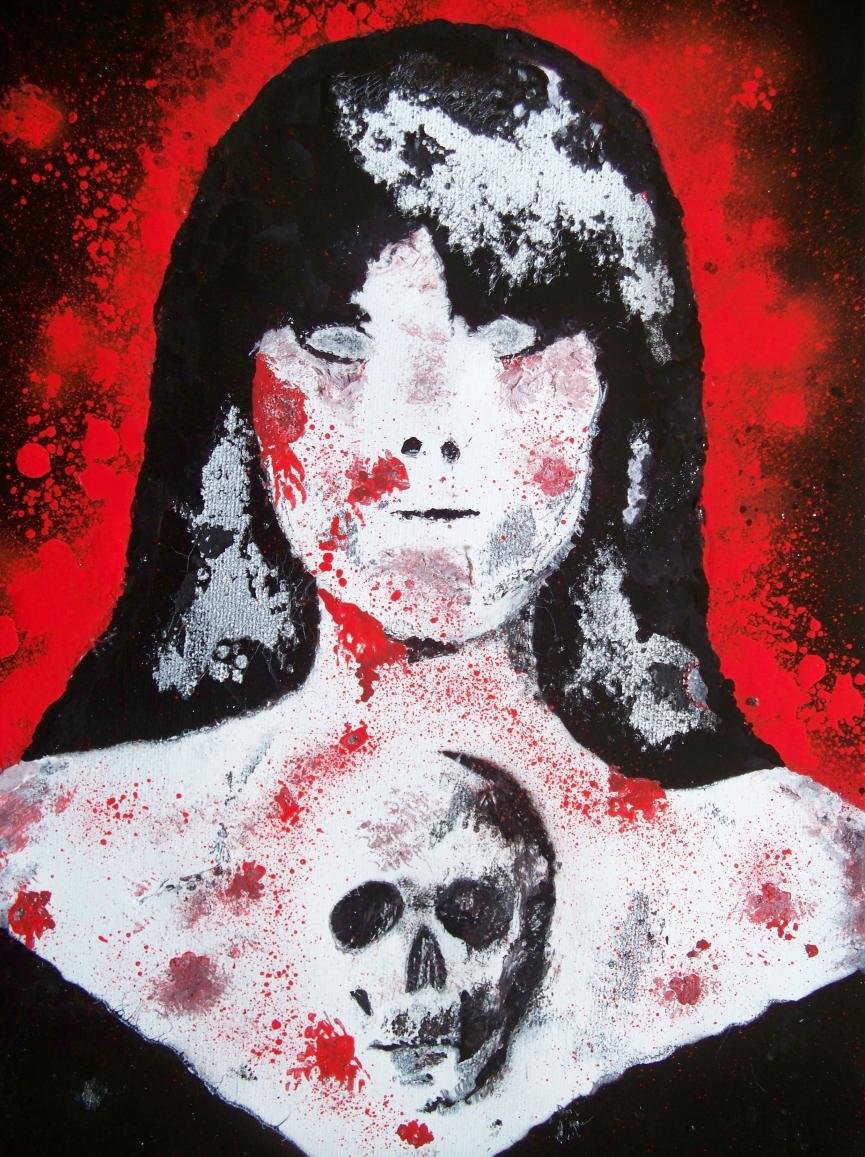Details
- 2013-03-04
- 0
- 93
- 2013
- Painting
- Aerosol Paint
- Religion
Pricing
Price and availability not indicated

- DIES SANGUINIS -
Description by Mister 13
Aerosol spray and kleenex on canvas, 2 coffee, 3 cigarette. Human sacrifice is the act of killing one or more human beings as part of a religious ritual (ritual killing). Its typology closely parallels the various practices of ritual slaughter of animals and of religious sacrifice in general. Human sacrifice has been practiced in various cultures throughout history. Victims were typically ritually killed in a manner that was supposed to please or appease gods, spirits or the deceased, for example as a propitiatory offering, or as a retainer sacrifice when the King's servants are killed in order for them to continue to serve their master in the next life. Closely related practices found in some tribal societies are cannibalism and headhunting. By the Iron Age, with the associated developments in religion (the Axial Age), human sacrifice was becoming less common throughout the Old World, and came to be looked down upon as barbaric in pre-modern times (Classical Antiquity). Blood libel is a false charge of ritual killing. The idea of human sacrifice has its roots in deep prehistory, in the evolution of human behaviour. Mythologically, it is closely connected, or even fundamentally identical with animal sacrifice. Walter Burkert has argued for such a fundamental identity of animal and human sacrifice in the connection of a hunting hypothesis which traces the emergence of human religious behaviour to the beginning of behavioural modernity in the Upper Paleolithic (roughly 50,000 years ago). Human sacrifice has been practiced on a number of different occasions and in many different cultures. The various rationales behind human sacrifice are the same that motivate religious sacrifice in general. Human sacrifice is intended to bring good fortune and to pacify the gods, for example in the context of the dedication of a completed building like a temple or bridge. There is a Chinese legend that there are thousands of people entombed in the Great Wall of China. In ancient Japan, legends talk about hitobashira ("human pillar"), in which maidens were buried alive at the base or near some constructions to protect the buildings against disasters or enemy attacks. For the re-consecration of Great Pyramid of Tenochtitlan in 1487, the Aztecs reported that they killed about 80,400 prisoners over the course of four days. According to Ross Hassig, author of Aztec Warfare, "between 10,000 and 80,400 persons" were sacrificed in the ceremony. In some notions of an afterlife, the deceased will benefit from victims killed at his funeral. Mongols, Scythians, early Egyptians and various Mesoamerican chiefs could take most of their household, including servants and concubines, with them to the next world. This is sometimes called a "retainer sacrifice", as the leader's retainers would be sacrificed along with their master, so that they could continue to serve him in the afterlife. Human sacrifice may be a ritual practiced in a stable society, and may even be conductive to enhance societal bonds, both by creating a bond unifying the sacrificing community, and in combining human sacrifice and capital punishment, by removing individuals that have a negative effect on societal stability (criminals, religious heretics, foreign slaves or prisoners of war). But outside of civil religion, human sacrifice may also result in outbursts of "blood frenzy" and mass killings that destabilize society. Thus, the Thuggee cult that plagued India was devoted to Kali he goddess of death and destruction. The Thuggee cult was responsible for approximately 2 million deaths. Many cultures show traces of prehistoric human sacrifice in their mythologies and religious texts, but ceased the practice before the onset of historical records. The story of Abraham and Isaac (Genesis 22) is an example of an etiological myth explaining the abolition of human sacrifice. Similarly, the Vedic Purushamedha (literally "human sacrifice") is already a purely symbolic act in its earliest attestation. According to Pliny the Elder, human sacrifice in Ancient Rome was abolished by a senatorial decree in 97 BCE, although by this time the practice had already become so rare that the decree was mostly a symbolic act. Human sacrifice once abolished is typically replaced by either animal sacrifice, or by the "mock-sacrifice" of effigies, such as the Argei in ancient Rome. When the largest black meteorite in the world came to Rome in 204 BCE along with the worship of Cybele as Magna Mater (Great Mother) and Protector of Rome, the ceremonies and rituals of Attis came as well. Of all the ceremonies and festivals associated with Attis, the most important was known as Black Friday and Dies Sanguinis (the Day of Blood) on or around the 25th of March, nine months before the solstice festival of his birth on 25th December. On the Friday closest to March 25th, the image of Attis was carried to the temple and bound to the tree, escorted by "reed-bearers" with the reed scepters representing re-generated phalli and new fertility. During the ceremonies, initiated castrastred themselves in imitation of the castrated god, and presented their severed genitals to the Goddess along with those of the gelded bull sacrificed at the Taurobolium. All these male remnants were deposited in the sacred cave of the Great Mother. On Black Friday, Attis, the saviour god died and was buried. He descended into the underworld (Hell). On the third day he rose again from the dead. His worshippers were told: "The god is saved; and for you also will come salvation from your trials." This day was the Carnival or Hilaria, also known as the Day of Joy. People danced in the streets and went about in disguise, indulging in horseplay and casual love affairs. Thus was the Sunday; the god arose in glory as the solar deity of a new season. Christians ever afterward kept Easter Sunday with carnival processions derived from the mysteries of Attis. Like Christ, Attis arose when "the sun makes the day for the first time longer than the night." The bursts of capital punishment during European witch-hunts, or during the French Revolutionary Reign of Terror show similar sociological patterns. Ritual killings perpetrated by individuals or small groups within a society that denounces them as simple murder are difficult to classify as either "human sacrifice" or mere pathological homicide because they lack the societal integration of sacrifice proper. The instances closest to "ritual killing" in the criminal history of modern society would be pathological serial killers such as the Zodiac Killer, and mass suicides with doomsday cult background, such as the Peoples Temple,Order of the illuminati, the Freemasons, Movement for the Restoration of the Ten Commandments of God, Order of the Solar Temple or Heaven's Gate incidents. Other examples include the "Matamoros killings" attributed to Mexican cult leader Adolfo Constanzo and the "Superior Universal Alignment" killings in 1990s Brazil. In modern times, even the practice of animal sacrifice has virtually disappeared from all major religions (or has been re-cast in terms of ritual slaughter), and human sacrifice has become extremely rare. Most religions condemn the practice, and present-day secular laws treat it as murder. In a society which condemns human sacrifice, the term ritual murder is used. In India, Sati, the immolation of a widow on her husband's funeral pyre, continued well into the 19th century, but is now very rare. The modern human sacrifice still living in our time, just think about the death row and the massive killing in every single country of our world, from Africa to Asia. Different ages, same brutality.







